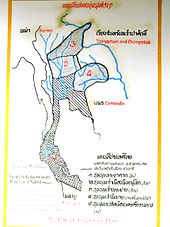Kingdom of Nakhon Si Thammarat
The Kingdom of Nakhon Si Thammarat (also: Kingdom of Nagara Sri Dharmaraja or Kingdom of Ligor ) was one of the autonomous city-states ( Müang ) of the Thai in what is now southern Thailand from the 13th to the 18th century . It was successively dependent on the kingdoms of Sukhothai and Ayutthaya . It controlled a large part of the Malay Peninsula .
Foundation and Sukhothai period
Most historians identify the Indianized state of Tambralinga , which has existed since at least the 10th century, with Nakhon Si Thammarat. Tambralinga belonged at least temporarily to the Buddhist sea kingdom or network ( mandala ) Srivijaya . The oldest Buddhist temples in Nakhon Si Thammarat ( Wat Phra Mahathat ) and Chaiya date from the 8th century. Which ethnic group (s) Tambralinga settled and ruled at that time is just as unclear as the circumstances under which the Thai took over the area in the 13th century.
During the reign of King Ramkhamhaeng (r. 1279-1298) of Sukhothai , Nakhon Si Thammarat was - according to a stone inscription dated to 1292 - the southernmost extension of his sphere of influence and was ruled by one of his relatives as a vassal ruler. Theravada Buddhism practiced in Nakhon Si Thammarat was a model for the whole Sukhothai kingdom. After Ramkhamkaeng's death, Nakhon Si Thammarat became independent again and controlled a number of dependent cities and principalities on the Malay Peninsula.
Ayutthaya period
From the reign of King Borommatrailokanat (ruled 1448–1488) Nakhon Si Thammarat was then a vassal of the Kingdom of Ayutthaya . In Palatinat -law of 1468 Nakhon Si Thammarat as one of the eight major cities (was Phraya MahaNakhon ) listed belonging to Ayutthaya. However, it retained its own dynasty and continued to have vassals, whose dependence it mediated to Ayutthaya, so to speak. In the 16th century, under King Naresuan , Nakhon Si Thammarat became a First Class Province ( Müang Ek ) in the Kingdom of Ayutthaya, ruled by appointed governors. The position was often passed on from father to son in a quasi-dynastic manner.
Nakhon Si Thammarat was one of the most important provinces in the south and had a primacy over the surrounding provinces. Its role in international trade (for example with Dutch and Portuguese traders) and the resulting wealth, as well as the great distance from the capital, encouraged a certain sense of independence. In 1629, when there was fighting for the throne in Ayutthaya, Nakhon Si Thammarat rebelled against the new king Prasat Thong . He sent the Japanese adventurer Yamada Nagamasa with his mercenary troops to put down the uprising and appointed him governor and ruler of Nakhon Si Thammarat.
There was a renewed uprising of the local governor after the usurpation of the throne in Ayutthaya by Phetracha after the "revolution" of 1688. After the fall of Ayutthaya in 1767, the lord of Nakhon Si Thammarat again declared himself with the provinces on the Malay Peninsula that he controlled for independent. However, it was subjugated as early as 1769 by the new king Taksin , the founder of the Siamese kingdom of Thonburi .
Integration into the Thai unitary state
King Rama I , founder of the Chakri dynasty , which is still ruling today, reduced Nakhon Si Thammarat from a vassal rule to a province of the first degree in 1782 (ruled by a governor with the rank of Chaophraya ) and withdrew his control over Patani and the northern Malay states, which he placed under the governor of Songkhla instead . The Kalahom (Minister of the Southern Provinces) was in charge.
With the thesaphiban administrative reform of Prince Damrong Rajanubhab towards the end of the 19th century, Nakhon Si Thammarat was completely incorporated into the Siamese Empire. In 1896 a new administrative unit, a Monthon, was created, which consisted of the areas on the east coast of the peninsula, today's provinces of Nakhon Si Thammarat , Phatthalung and Songkhla . After the end of the absolute monarchy in 1932, these large units were abolished and each province was directly subordinate to the central government.
literature
- Stuart Munro-Hay: Nakhon Sri Thammarat: The Archeology, History and Legend of a Southern Thai Town . White Lotus Press, Bangkok 2001, ISBN 974-7534-73-8


